“Baskets and Dancing Blankets,” Ensign, July 1977, 74
Special Issue: The Arts
Baskets and Dancing Blankets
In a worldwide Church, appreciating all cultures’ art is a real part of day-to-day brotherhood.
Rain-drenched mountains drop abruptly into the sea. Ocean fjords cleave through 8,000-foot mountains. Killer whales, dogfish, salmon, beavers, grizzly bears, frogs, and Tsoonaquas inhabit rainswept saltwater, rivers, and thick forests. And here and there, on those rare level places between the mountains and the sea, the Salish, Kwakiutl, Nootka, Bella Coula, Tsimshian, Haida, Tlingit, and Chilcat Indians of the Northwest Coast of North America build their villages.
I met these places, creatures, and people in a class during my first quarter in graduate school. The professor, Bill Holm, a soft-spoken man, introduced us to the stories, songs, rituals, dances (which he sometimes performed for us wearing huge carved wooden masks), painting, and carving of these Indians. He and his entire family were adopted Kwakiutls, a rather lengthy and costly process in Kwakiutl society, and the involvement of this blond, blue-eyed Swedish American was so intense that he actually could have been an Indian, except for an accident of birth. His enthusiasm and knowledge inspired me, but it was his deep respect for the Northwest Coast Indians and their art that had the deepest impact on me. In some significant ways, it changed my life.
We don’t always have the kinds of experiences that let us understand another culture from the inside. That’s a rich experience. And one side-effect is equally valuable—it helps us understand our own culture more profoundly. One of the privileges of the gospel—available to any member of the Church—is that special kind of brotherhood based on understanding. Gaining understanding of another people’s total culture is a long process, but that class taught me some valuable keys in understanding art, an important part of any people’s culture.
First, to appreciate the beauty of another culture’s art I had to learn to see it as they see it, understanding the aesthetics and logic that cause them to put colors, shapes, and textures together in particular configurations.
Second, the highest levels of artistic visual expression are not limited to oil paintings and marble and bronze sculpture. A housefront is often a village’s finest painting. Highest quality sculpture can be found on such diverse items as a forty-foot totem pole or the handle of a spoon.
Third, it is important to understand how a piece of “art” functions in a society. For example: totem poles were used to display the heraldic crests of their owners—similar to displaying a coat of arms. Early Catholic and Protestant missionaries to the Northwest Coast thought the totem poles were worshipped as idols by the Indians, and they chopped down many poles that often were the Indians’ finest sculpture and symbols of their family history. Yet the missionaries were not being malicious, only lacking in understanding.
As we were to learn in our classes, similar problems arose all too frequently whenever two different cultures came together. The native arts were either rejected as pagan idols or dismissed as insignificant local “crafts,” unworthy of the title of “art.” Responding sympathetically at seeing such insensitivity made me examine my own Western cultural biases, and I found that I shared some of the same prejudices.
Western man too often assumes a morally and aesthetically superior position, based upon his greater technological and military power. This feeling of superiority was buttressed philosophically in the nineteenth century when Darwin’s theory of biologic evolution was uncritically adopted to explain whole peoples and cultures: because machines made survival easier it was presumed that the cultures that produced and used machines were “superior” to those that did not. Some of these evolutionists regarded non-Western art as simply primitive attempts to achieve the true, superior, and—incidentally—Western art which stressed a “realistic” view of the world. According to them, the classical models of the Renaissance were the only possible ideal. Such tunnel vision is like assuming that the only edible vegetable is an artichoke.
We know that different peoples express their artistic ideas in different visual ways. For example, if one went to the Hopi Indians looking for “art” with the preconception that art consists of representational paintings to be hung on walls, one would find no art. The Hopis do their painting on pottery. On the other hand, if a Hopi walked into a museum filled with oil paintings by Rembrandt he might similarly wonder, “Where is the art?”
Here’s another example: perhaps the finest aesthetic creations of the Chilcat Indians of southeastern Alaska are their beautiful dancing blankets. The patterns, repeating variations of a limited number of elements, have the conceptual sophistication of a Bach fugue. These weavers made masterpieces. To enjoy them fully, we need to train our eyes to perceive the relationships of the patterns being used and also to recognize how textiles are a “high art form” worthy of the time it takes us to see it from the Chilcat perspective.
A Chilcat would never throw away even a fragment of a dancing blanket, so long as it in any way physically hung together. Such cloth is so highly valued that small pieces are preserved and used on dancing aprons. When I finally came to appreciate this, I asked myself if I had any clothing I would not throw away after it was worn out. Looking through our closet, I had to admit that I owned nothing so important to me that I would save even its tatters.
Let’s look at another example of an art form in another culture that has little value or aesthetic association in Western culture: basket weaving. When I was a student, my friends and I heaped scorn on classes we thought of as irrelevant by calling them “underwater basket weaving.” For us, basket weaving was a synonym for uselessness and superficiality. With a certain amount of humility, I’ve come to realize that all cultures do not regard basket weaving so contemptuously.
In the early 1950s President David O. McKay made a trip to the South Pacific to see the Saints. As he went from island to island visiting the Saints in Polynesia, they gave him gifts of their most exquisite handmade objects, now part of the fine Polynesian collection of the Church Historical Department. And what kinds of objects were included? Baskets! Carefully patterned, perfectly shaped and woven, these baskets give a silent and lovely lesson of intercultural understanding every time I see them. What handmade object would your ward or stake give to President Kimball if he made a special trip to see you and you wanted to give him your finest? In the American West we might give a beautiful handmade quilt, lovingly and meticulously fashioned by Relief Society sisters. What would other peoples do?
Pottery, textiles, and baskets are not generally considered the pinnacle of artistic expression in Western culture. But as we move from culture to culture we see how areas of aesthetic interest and creativity vary. If we don’t shift perception to understand this, we may miss the finest creativity of a whole people. Insensitivity to the beauties of a people’s artistic creations could breed an intolerance toward their whole culture.
How does all of this relate to the Church and the gospel? In the nineteenth century the vast majority of converts to the Church came from the eastern United States, Canada, Great Britain, and northwestern Europe, bringing with them some of the most cherished elements in Latter-day Saint cultural heritage. For instance, the Tabernacle organ was built by Joseph Ridges, a young English convert who came to Utah from the gold fields of Australia. C. C. A. Christensen and Dan Weggeland, both from Scandinavia, gave us some of our finest paintings of early Church history. A young Englishman named William Clayton wrote words for one of our favorite hymns, “Come, Come, Ye Saints.”
Two things happened to make their efforts successful contributions. The people mentioned used their talents in the service of the kingdom. And members of the Church recognized the value of their contributions. Of course, since all members of the Church were from the same general cultural framework, acceptance was fairly easy. But what happens when the cultural frameworks are rather different? Some of the Church’s major growth today is in such areas as Latin America, the South Pacific, and the Far East. There are some major differences between these cultures and the North American/Western European cultures from which the vast majority of the Saints have traditionally come. Artistic expressions and forms reflect these differences.
The kind of cultural richness we can expect in the next few decades from this mingling is one of the exciting parts of being a Latter-day Saint for me. Yet from my responses to non-Western art, I know that two obstacles can cut us off from this richness. One is the kind of self-centeredness that makes us equate “different” with “inferior” or “wrong.” This is the reaction that the Protestant and Catholic missionaries had to the totem poles, and I’m sure that we could find examples of the same kind among ourselves.
The second obstacle is our own ignorance of the principles of the gospel. If we do not study the scriptures, pray constantly for the companionship of the Holy Ghost, and struggle for more light and truth, we may accept all of the traditions of our fathers without being able to tell which ones are based on righteous principles and which ones are merely the result of habit and convenience.
The early apostolic church faced this problem of multiplicities of cultures. For example, some argued that circumcision was necessary for new members of the Church. But Paul pointed out that though it had become a Jewish cultural tradition, it was not a requirement to enter the church of Jesus Christ. The New Testament records that Paul’s broader framework was adopted.
I sometimes think that we Western-culture-oriented Saints seek that same kind of cultural change of new converts from other lands, cultural surgery to remove elements that are different from North American Mormon culture but not at all antithetical to the gospel of Jesus Christ. There are aspects of all cultures that are antithetical to the gospel and should be dropped. However, when we approach a totally different culture with the cultural scalpel, we need to be absolutely certain that we know what these cultural expressions really mean to the people that created them. Sorting this out is often difficult, but it is essential. For example, I wonder how comfortable we would feel if we were suddenly dropped into the culture of Nephi or Paul, or even that of Brigham Young’s Utah.
President Brigham Young urged the Saints to expand their abilities to perceive and appreciate goodness in a diversity of places:
“Whether a truth be found with professed infidels, or with the Universalists, or the Church of Rome, or the Methodists, the Church of England, the Presbyterians, the Baptists, the Quakers, the Shakers, or any other of the various and numerous different sects and parties, all of whom have more or less truth, it is the business of the Elders of this Church (Jesus, the elder brother, being at their head,) to gather up all the truths in the world pertaining to life and salvation, to the Gospel we preach, to mechanism of every kind, to the sciences, and to philosophy, wherever it may be found in every nation, kindred, tongue, and people, and bring it to Zion.
“The people upon this earth have a great many errors, and they have also a great many truths. This statement is not only true of the nations termed civilized—those who profess to worship the true God, but is equally applicable to pagans of all countries, for in their religious rites and ceremonies may be found a great many truths which we will also gather home to Zion. All truth is for the salvation of the children of men—for their benefit and learning—for their furtherance in the principles of divine knowledge; and divine knowledge is any matter of fact—truth; and all truth pertains to divinity.” (Journal of Discourses, 7:283–84.)
During my study of native art I read a book by a wise man that stated the same idea in a different way:
“Our first task in approaching another people, another culture, another religion, is to take off our shoes, for the place we are approaching is holy. Else we may find ourselves treading on men’s dreams. More serious still, we may find that God was here before our arrival.” (John V. Taylor, The Primal Vision, London: SCM Press, 1958.)
Each culture has worthy art. If I look at its internal consistencies instead of comparing it against a different framework, it comes alive for me. The old saying about not comparing apples and oranges is very true when viewing the art of another culture or another time. When we understand that, it becomes easier for us to learn beauties and truths from our fellow Saints, regardless of their origins, and we also gain a respect and love for the lands of their birth. The potential for an even richer Latter-day Saint cultural tradition developing in such an environment of mutual respect is exciting.
This process, of course, will not be easy, for one of the great challenges facing Latter-day Saint artists throughout the world is learning to communicate in visual language. Visual, nonverbal language is called iconography. It is based upon the use of a series of symbols that stand for ideas. It is a way of preaching the gospel to our eyes instead of just our ears. A Mormon iconography is slowly developing. For instance, a statue of the Angel Moroni on the spires of many of our temples stands for fulfillment of prophecy about the Restoration. It also reminds us that the Lord has sent heavenly messengers to teach and reveal truths to us in this dispensation. It is a symbol so widespread that it is recognized by virtually every member of the Church.
The Salt Lake Temple has become another visual symbol. The famously thick granite walls denote millennial permanence. The temple also symbolizes links with our departed ancestors and the creation of permanent bonds between worthy marriage partners and their families.
One of the creative challenges to Latter-day Saint visual artists is to develop a broader visual vocabulary to communicate a greater variety of gospel truths. A special responsibility will be to create not only an enlarged visual language, parts of which may come from many cultures, but also a visual language that can easily be understood by the vast majority of the Saints. Aesthetics of art from differing cultures will vary, but clearly understood iconography can cross cultural aesthetic boundaries.
There have been few opportunities in the history of the world for as many diverse cultures to come together for common goals as we have with the growth of the world Church.
Mutual love, based on the brotherhood of the gospel and revealed truths and authority, link us together. A deeper understanding of the expressions of Saints from other cultures could deepen our respect for each other as people. It must be an understanding that goes beyond curio seeking. It must be an effort that attempts to see the artistic creations of other Saints as they see them. We must learn aesthetic and visual “languages” as we learn spoken and written languages. Such a task will not be an easy one. But the effects of such an outreach by both artists and viewers to communicate and understand should result in the greatest flowering of culture the Church has ever known.
The first prophet of this dispensation pointed the way when he wrote: “If there is anything virtuous, lovely, or of good report or praiseworthy, we seek after these things.” (A of F 1:13.)
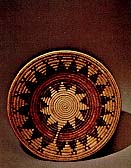
A Navaho wedding basket (Collection, Church Historical Department; 18 inches diameter).
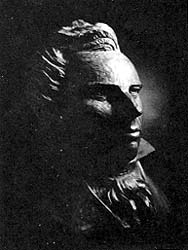
This bust of Joseph Smith is one of several carved by a Lamanite Latter-day Saint living in Quito, Ecuador (Collection, Church Historical Department).
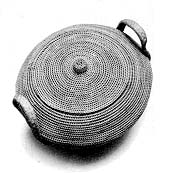
Basket from the South Pacific (Collection, Church Historical Department).

A Hopi wedding vase made by Carol Namoki, a Latter-day Saint from Hano village, First Mesa, on the Hopi Reservation in Arizona. Filled with water and herbs, the vase is given to the couple: the groom drinks from one spout, the bride from the other. Then the elder marrying them pours the rest of the liquid to the ground at the door of their house and returns the pot to the couple, telling them their marriage should last like a fine piece of pottery (Collection, Church Historical Department).
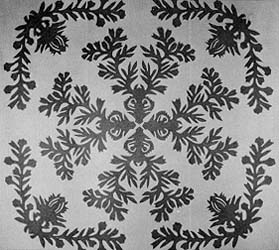
A quilt made by Hawaiian Saints, large enough for a full-size bed, which was given to President Kimball after the first Pacific Area Conference (Collection, Relief Society).

The item on the right is a woomera made by Australian aborigines. A spearthrower, it is used by holding it over the shoulder and casting the spear with a flipping motion. The item on the left is a paddle from the Marquesas Islands in French Polynesia (Collection, Church Historical Department).
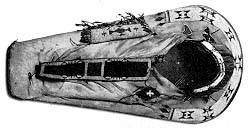
A Dakota (Sioux) papoose board from the turn of the century (buckskin and beads, 42 inches long).

This tapa cloth from Polynesia depicts the eagle gate and the tabernacle organ facade. “Ko e okane i saione” means “the organ in zion” in Tongan (Collection, Church Historical Department; panel shown is 3 feet wide).
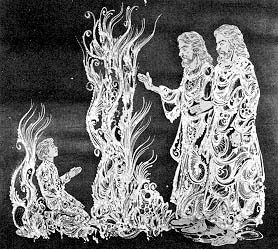
This batik depicting the first vision, made by applying wax and then dying the fabric, was given to President Kimball by some of the first Indonesian Saints married in the temple, and is a beautiful example of gospel subject matter being treated in the art forms familiar to the local Saints (Collection, Relief Society; gold figures on purple background, about 3 feet square).
Sculpted pot by Teresita Naranjo, a Pueblo potter from New Mexico. This form of pottery is the Pueblo’s expression of sculpture (Indian Art Center, Salt Lake City, Utah).
A Chilcat “dancing blanket,” so highly regarded that even the fragments are saved. The warp of the blanket is spun from mountain sheep wool and cedar bark, which makes the fabric stiff enough to stay open during the dance, allowing the pattern to be clearly seen at all times (Museum of the American Indian, New York, NY; about 6 1/2 feet wide).
A totem pole carved by Bill Reid, a Haida Indian whose work has been exhibited worldwide. Early Christian missionaries thought that totem poles were idols and tried to destroy them all (University of British Columbia, Vancouver, BC; western red cedar, 3 feet diameter).
Tevita Polaápau, a nineteen-year-old Maori Latter-day Saint, was strongly influenced by Western painting styles in creating this scene of missionaries baptizing. The painting hangs at the Church College of New Zealand.
Maori artist Buck Nin, a Latter-day Saint who teaches at the Church College of New Zealand, has a distinctively Maori flavor in his work, and many of his paintings reflect his concern for the preservation of Maori culture. This painting, Rotorua, is acrylic on canvas (3 1/2 feet by 3 feet).
Photography by Jed Clark